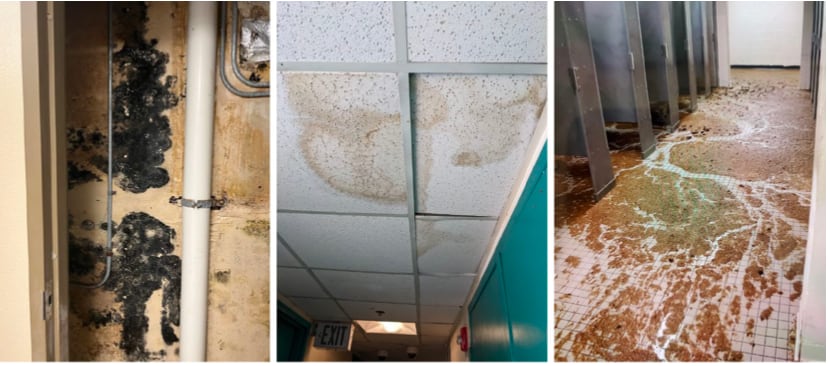Haphazard planning and shoddy oversight from Pentagon leadership has subjected thousands of rank-and-file service members to dirty and dangerous living conditions in military barracks, government investigators have found.
The 118-page Government Accountability Office report, published Tuesday, documented widespread housing issues, many of which are already familiar to many lower-ranking service members across the armed forces — mold, dysfunctional plumbing, no heating in the winter, no air conditioning in the summer. Investigators warned that these conditions risk undermining the military’s readiness and morale.
GAO officials visited barracks at ten different military installations and analyzed service member housing satisfaction data dating back to 2019. They found that “some military barracks do not meet DOD minimum standards for assignment or occupancy.”
“We observed and military service members and officials told us that living conditions in some barracks pose potentially serious risks to health and safety and that not all barracks meet minimum privacy and configuration standards,” they note in their report.
Service members at five of the ten installations reported regular water issues; four installations reported broken or malfunctioning fire safety infrastructure. All ten reported mold infestations and “broken, malfunctioning, or non-existent heating, ventilation, and air conditioning systems.”
Investigators also documented broken door locks and first-floor windows at three installations. They observed “insufficient lighting, vacant units occupied by unauthorized personnel, or no existing or working security cameras” at seven installations.
Maintenance teams tend to be slow or unresponsive. GAO officials found that some installations require residents to take care of quality-of-life issues themselves. According to the report, officials at one installation said service members are responsible for cleaning up the “biological waste” that might stain a room after a suicide.
“It takes longer than a month, sometimes three months, for maintenance to come and check out an issue,” one resident told investigators.
Some barracks are faulty by design, according to the report. DOD housing standards mandate that troops living in units without a living room should each have a private bedroom and share a bathroom with no more than one other person. Room layouts at six installations violate these guidelines.
Service members told GAO officials that the condition of these living spaces worsen the mental and physical health of their residents. Officials and troops also stressed that poor living standards disincentivize reenlistment and scare away prospective enlistees.
“Service members consider leaving the military because they are miserable [in barracks],” one senior enlisted member told investigators. “They want to control how they live.”
Despite an abundance of complaints and billions of dollars allocated toward “facility sustainment,” the Pentagon has struggled to bring barracks up to par.
Investigators note that DOD has deferred $137 billion in installation maintenance costs as of 2020. Much of the money that has trickled through is pipelined towards “mission-critical facilities,” leaving barracks by the wayside. When pressed by GAO officials to detail how much sustainment funding would be dedicated to barracks renovations, DOD officials struggled to provide specific estimates, investigators added.
The report also faults the defense department’s “unreliable” system for assessing the quality of life on installations.
The military assigns facilities a “condition score” from 0 (worst) to 100 (best). Investigators discovered that a number of barracks with condition scores above 80 needed “significant improvement.” Officials at one installation described the barracks as “uninhabitable,” even though its condition score passed 90.
The GAO recommended that the DOD conduct more thorough and frequent assessments of its barracks to keep tabs on conditions. It also suggested that the branches tidy their budgets to streamline renovation funds to where they’re needed most.
The Defense Department has concurred or partially concurred with all of the GAO’s 31 recommendations, according to the report.
Jaime Moore-Carrillo is an editorial fellow for Military Times and Defense News. A Boston native, Jaime graduated with degrees in international affairs, history, and Arabic from Georgetown University, where he served as a senior editor for the school's student-run paper, The Hoya.





